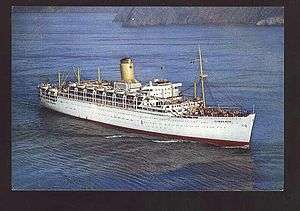SS Himalaya
 | |
| History | |
|---|---|
| Name: | SS Himalaya |
| Namesake: | Himalaya |
| Owner: | Peninsular and Oriental Steam Navigation Company |
| Operator: | 1949-1961 P&O Lines, 1961-1966 P&O-Orient Lines, 1966-1974 P&O Lines |
| Port of registry: |
London, |
| Route: | Tilbury-Gibraltar-Marseilles-Naples-Port Said-Aden-Bombay-Colombo-Singapore-Fremantle-Adelaide-Melbourne-Sydney |
| Ordered: | March 1945 |
| Builder: | Vickers-Armstrongs, Barrow-in-Furness, UK |
| Cost: | £3,500,000 |
| Yard number: | 951 |
| Laid down: | 26 February 1946 |
| Launched: | 5 October 1948 |
| Completed: | August 1949 |
| Maiden voyage: | 6 October 1949 |
| Out of service: | 30 October 1974 |
| Identification: |
|
| Fate: | Scrapped, 1975 |
| General characteristics [2] | |
| Type: | Passenger ship |
| Tonnage: | |
| Length: | |
| Beam: | 90 ft 8 in (27.64 m) |
| Draught: | 31 ft 2 in (9.50 m) |
| Propulsion: |
|
| Speed: | 22 knots (41 km/h; 25 mph) |
| Capacity: | As built, 758 1st class, 401 tourist class (1963, 1416 tourist class) |
| Crew: | 572 |
SS Himalaya was British passenger ship of the Peninsular and Oriental Steam Navigation Company, launched in 1948, which operated mainly between Britain and Australia. She was withdrawn from service in 1974 and scrapped the next year.
_-_BEIC_6328625.jpg)
Himalaya was built at Barrow-in-Furness by Vickers-Armstrongs and launched 5 October 1948. She had an identical hull and machinery to Orient Lines' Orcades (yard no. 950 to Himalaya's 951), though differing in superstructure and internal layout. She began her service on the Tilbury-Bombay-Australia route in 1949 following her departure from the shipbuilding yard in August. During her commission Himalaya underwent a number of improvements the first of which was, although controversial at the time, a funnel cowl to keep the liner's decks clear of debris without interference to the boilers. Following the sale of the Strath Class liners by P&O Himalaya (along with Orcades) was converted to allow the transportation of tourist class passengers only.
Himalaya arrived at Sydney on 30 October 1974 on her final commercial voyage. She was sold to Tong Cheng Steel Manufacturing Co. Ltd, and scrapped in Kaoshiung, Taiwan, in 1975.[3]
See also
References
- 1 2 3 "HIMALAYA". shipspotting.com. Retrieved 8 December 2012.
- ↑ "Himalaya: Technical Statistics". The AJN Transport Britain Collection. 2007. Retrieved 8 December 2012.
- ↑ "Himalaya: History". The AJN Transport Britain Collection. 2007. Retrieved 8 December 2012.